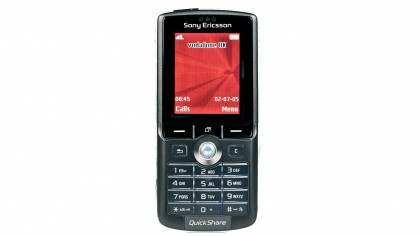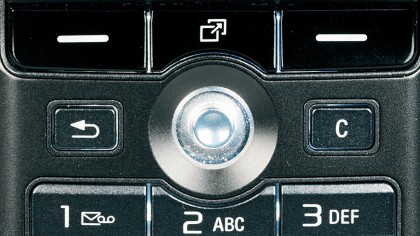Retro Phone Review: Sony Ericsson K750i
Back in 2005 we asked: who needs 3G anyway?
Most cameraphones don't focus the lens before taking the picture. The lens is fixed on a spot a few feet away, and then relies on the tremendous amount of depth of field that small-sensor digital cameras can produce from their wide-angle lenses to ensure that everything is sharp.
However, this means that you can't take shots right up close to your subject. Autofocus (AF) changes all of this, as the lens can adjust to suit the subject distance.

The AF takes some getting used to and you need to press the trigger part way down to activate the autofocus system. You see the target lock, and if it takes a satisfactory reading it will beep to tell you that it is ready to shoot. You see the result of the adjusted focus on-screen – and this is a good thing because the autofocus system can't tell what part of the scene you want in sharpest focus.
It guesses that it is in the middle of the scene, and if it's not, you have to train the camera on the item you want sharp, activate the focus and lock it, before recomposing the picture.
It sounds complicated, but it is what normal cameras require you to do. And besides, the benefit is that you can really fill the frame with images. There is even a switchable Macro facility, which will allow the lens to focus automatically to within just a couple of inches of the subject.

This is superb for making 'photocopies' of pieces of texts or illustrations that you might want to keep for future reference (and ideal for collating low-cost wallpapers images). If we were being picky, the lack of an optical zoom lens is a touch disappointing but the 4x electronic zoom can be used at the top resolution setting.
The top two-million pixel setting generates JPEGs that average around the 350KB mark in size. This number of picture elements means that you can produce 8x6inch prints using the usual 200dpi benchmark used for inkjet printers; you can also reproduce images at 5x4inches using the more demanding 300dpi used in professional printing.
Get daily insight, inspiration and deals in your inbox
Sign up for breaking news, reviews, opinion, top tech deals, and more.
The pictures delivered in our own field tests were extremely impressive – streets ahead of what is produced by a normal cameraphone. There was good detail, and exposure although not spot on,was accurate enough even in tricky lighting and with difficult subjects. Colour balance was also exemplary.
We did note, however, that picture quality improved markedly in good light. In low light you do have the option of using the built-in flash, which does a good job of raising the illumination level, but does little for the aesthetics of the shot.
This camera also gives you a lot more creative and fun controls than many other models. There are 20-odd borders to superimpose over your shots, for instance, as well as some nicely-executed digital effects.
There is a handy panoramic feature that not only stitches three shots together for you to make a widescreen vista, it actually provides a ghost image of the previous frame, so that each section lines up with the last as perfectly as possible.
You can, of course, shoot movies with the camera – although the resolution then falls to 176x144 pixels.
The audio quality produced by the music player is also extremely good. There's real punch to tracks played over the headphones, although you do have to watch that you don't crank the volume up too high if you are to avoid distortion.
Not only can you load your own music using the MemoryStick or the supplied USB lead, there is also direct access to the PlayNow download server, which will play snippets of tracks for you to taste, before you pay £3 a pop to have them transferred in full to your phone.
If you do not like paying for the latest sounds, then there is always the built-in radio. This FM tuner allows you to keep entertained and up-to-date without the need to pay for downloads or WAP pages.
The phone is supplied with a good library of onboard software. Our test sample came with an luxurious-looking aerial combat game, and a quality tennis simulator; there is also a picture puzzle game which you can use to turn your photographs into electronic jigsaws.
Just as useful and entertaining is the DJ suite of programs, which allow you to edit video, music and photographs on screen.
Performance
The great attraction of this phone is that it has got it all (well, almost). It offers full-feature Bluetooth as well as infrared. It will work in the States, thanks to tri-band operation. It has an email client. It can be controlled by voice commands.
When you add this to the music, download, memory and camera capabilities you have a real winner.

Even the battery puts in a startling performance. We had to double check our notes. But the handset kept running for over a week on a single charge – 172 hours in total – during which we took a couple of dozen high-resolution pictures (and beamed them to a PC via Bluetooth), played with most of the different features, and made some 30 minutes of calls.
Voice quality, following in the Sony Ericsson tradition, was also first class – and signal strength gave us no cause for concern, despite the absence of an external aerial.
The price is even reasonable.With a suitable contract it can obviously be free for high-user deals; but for those who like to pay for their privileges it can already be found SIM-free for under £300.
Sure, there is no smartphone operating system – and we can't help but dream of a similarly sized 3G model. But if you are looking for the best GSM cameraphone that you can find, this is it.
Verdict
The Sony Ericsson K750i appeared just at the cusp of a time when traditional mobile phones were slowly transforming into the smartphones we know today.
So although the K750i didn't have an operating system or apps, it featured an impressive (for its time) camera and some decent media playing features.
Total Mobile was impressed enough by the K750i to give it 86% in issue 133, but a new wave of smartphones that would change how we used our handsets forever was just around the corner.